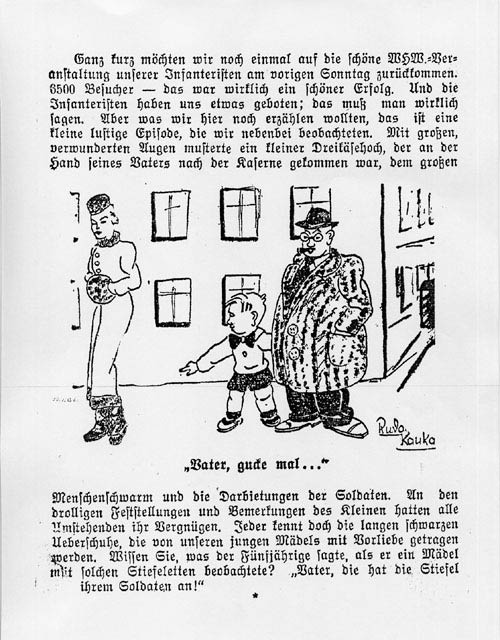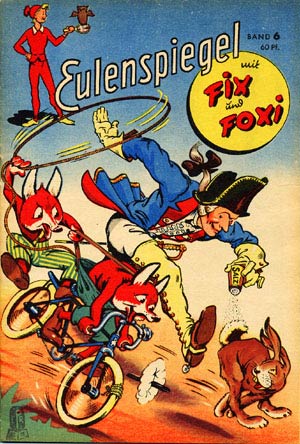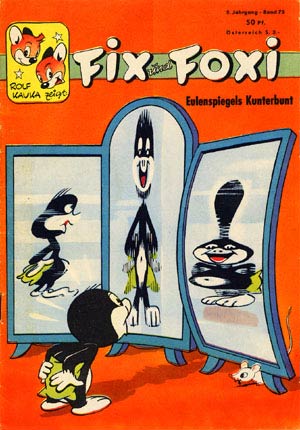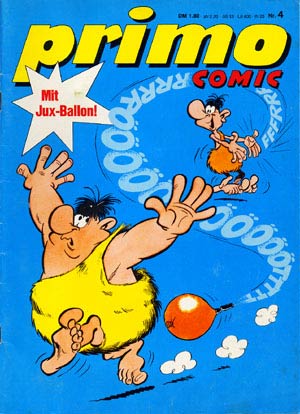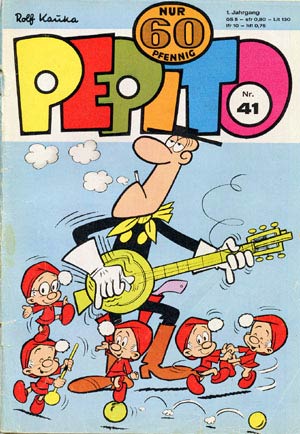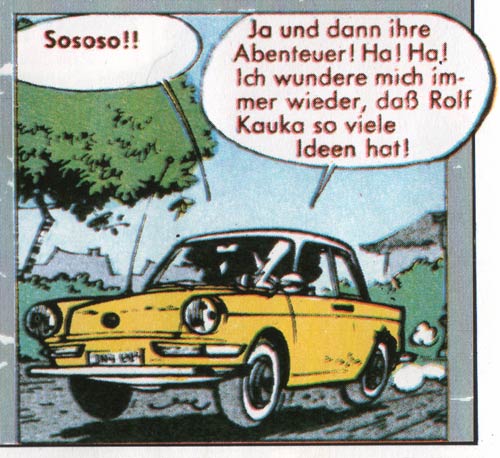'Fix, Foxi and Lupo', from Fix und Foxi #40, 1955.
Rolf Kauka was a German comics producer, publisher and entrepreneur, best known for his long-running comic magazine about the twin foxes 'Fix und Foxi' (1953-1994). Their funny animal universe was complemented by such characters as the wolf Lupo, the mole Pauli and the hare/hedgehog duo 'Hops und Stops', all of which also starred in their own stories. In addition, Kauka and his team launched enduring non-animal back-up features like 'Tom und Biberherz' (1957-1976), 'Mischa' (1961-1967, 1978-1980), 'Diabolino' (1964-1980s) and 'Die Pichelsteiner' (1966-1969), while the charming little bear 'Bussi Bär' (1973-2013) pleased generations of preschool readers. At the peak of its popularity in the mid-1960s, the weekly Fix und Foxi issues reached a print run of over 400,000 copies. A total of 7.5 million copies were sold, making Kauka's publications the driving force behind the West German comic industry for many years. Artists and writers from all over Europe were brought in to manage the production. Kauka's activities earned him the label of the "German Walt Disney", although his creations never really caught on abroad.
Cartoon for the Weißenfelser Tageblatt.
Early life
Rudolf Paul Alexander Kauka was born in 1917 in Markranstädt, a town in the Leipzig district of Saxony. His father was a blacksmith and wagon maker of Finnish descent. While still a student at the Friedrich-Liszt-Realschule in Leipzig, the young boy drew cartoons for local papers like the Leipziger Neueste Nachrichten and the Weißenfelser Tageblatt. After a three-year apprenticeship in a drugstore, he enlisted in the Wehrmacht in 1938 as a gunner in the 33rd Flak Regiment. He fought in World War II as an army officer.
Early publications
Back in civilian life, Kauka ventured into publishing, laying the foundations of his Kauka Verlag through several short-lived partnerships from 1947 onwards. Among his first releases were a guidebook for police officers by Dr. E.G. Mayers, a series of textbooks for law students by Dr. Norbert Pohl, and a magazine with news about inventions and technical knowledge. His first steps in the entertainment industry were the pulp novel series 'Der neue Filmroman' and 'Neues Kriminalmagazin'.
Based in Munich since 1949, Kauka expanded these activities with the launch of the cowboy novel series 'Bill Rocky' (1950), the men's magazine "ER - die Zeitschrift für den Herrn" and the fashion monthly Mix. In 1952, he released two series of collectable pictures, both with the then-popular cowboys and indians theme, as well as the youth magazine Colombo. The latter featured the first contributions of Dorul van der Heide, an artist of Dutch descent, and the original artist of Kauka's comics empire.
(Till) Eulenspiegel
American comic books stormed the West German market in the early 1950s, and Kauka decided to step in on their popularity. He began an association with Erich Pabel Verlag from Rastatt, who would publish the books produced by Kauka and his team. The first issue of (Till) Eulenspiegel was launched in May 1953, and completely drawn by Dorul van der Heide. Kauka chose German fairy tales, folktales and fables as the basis for his comics stories. The title character was the scoundrel Till Eulenspiegel from medieval German folklore, who was later given the stick figure Dagobert (an earlier Van der Heide creation) as his sidekick. 'Münchhausen's tolle Abenteuer' got its inspiration from the tall tales of Baron Munchausen, while animal fable characters were represented by 'Brummel und Knickebein' (starring a bear and a raven, 1953, named after the raven from Wilhelm Busch's 'Hans Huckebein') and 'Hops und Stops' (starring a hare and a hedgehog, 1954). The sixth issue marked the introduction of Fix and Foxi (1953), two young foxes inspired by the trickster fox Reynard. Their main antagonist was Lubo, a wolf based on Isengrim from the original fable.
Fix und Foxi
Kauka's foxes Fix & Foxi quickly captivated the readers' hearts. So much, that Eulenspiegel was renamed to Fix und Foxi from its 29th issue in 1955 on. The magazine initially appeared irregularly, then bi-weekly (from 1955 on) and from the 97th issue in 1957 it was a weekly. With the arrival of Kauka's art director and chief artist Walter Neugebauer, the series dropped its fable origins and developed into a more cartoony funny animal world of its own. A less realistic depiction of the two foxes made them more likable for a younger audience. Fix and Foxi were turned into cunning, open-minded and caring protagonists, who could serve as role models. The brash and opportunistic wolf, by now called Lupo, also lost most of his malicious traits. As a true bon vivant, he became the series' main comic relief and actual star.
Over the course of several years, new characters were introduced to enrich the Kauka universe. Lupo's grandmother Eusebia and niece Lupinchen arrived in 1957 and 1959, while Fix and Foxi's elderly and slightly pendant uncle Fax moved into their house in 1961. As a result, the otherwise independent foxes received a slight rejuvenation. 'Hops und Stops' appeared in back-up stories, often accompanied by professor Knox, who was a reinterpretation of the raven Knickebein. By 1961, the establishment of the town Fuxholzen was complete, when all characters moved into their own recognizable houses.
Pauli story from Fix und Foxi #484, 1965.
Pauli
Another major character in Fix und Foxi magazine was 'Pauli', largely developed by Van der Heide's assistant Werner Hierl. The mole had made his debut as a secondary character in the stories about the squirrel 'Niki' from the 18th Eulenspiegel issue in 1954. His early appearances were mostly characterized by the familiar mole traits: digging holes and shortsightedness. He continued to star in back-up stories, but got his definitive design in 1958. In a story cycle called 'Die Pauli-Familie', Pauli returned to his hometown Maulwurfshausen after years of dwelling in the woods. He too became younger, cuter and less one-dimensional, mainly under supervision of lead artist Branco Karabajic. While 'Fix und Foxi' used the "uncle-nephews" construction as the Disney universe, Pauli had parents and a sister, Paulinchen. Overlap between the worlds of Fuxholzen and Maulwurfshausen happened on occasion until 1962, but after that Pauli's adventures were unrelated to Fix und Foxi.
During the 1960s, Rolf Kauka personally welcomed the readers in each new issue. He also hosted the readers' mail page. Samples from issues 1968-28 and 1969-41.
Secondary characters
Throughout the 1950s and 1960s, the Kauka magazines launched several back-up features outside of the animal spectrum, some of which would prove quite enduring. Walter Neugebaeur created 'Tom und Klein Biberherz', also known as 'Tom und Biber' (1957-1976). Over the years, Vlado Magdic drew most adventures of this young cowboy and his Native American friend. Kauka's humorous sci-fi series about the heroic 'Mischa' ran as an adventure serial in Fix und Fox between 1961 and 1967, initially drawn by Becker-Kasch. He returned in the 1970s in Primo magazine and finally in the 1980s in the Gold Comic series, respectively drawn by Studio Berck and Josep Marti. The adventures of the bohemian tomcat and his friends, the mouse Pieps and the goose Daggi, appeared in Fix und Foxi from 1961 until 1967, and then again from 1978 until 1980. Florian Julino was the main artist of the little devil 'Diabolino', whose adventures appeared in the Kauka magazines from 1964 until the early 1980s. The Stone Age family 'Die Pichelsteiner' (1966-1988) ran in several of Kauka's companion titles, mostly drawn by Riccardo Rinaldi.
Other publications
By the mid-1960s, Fix und Foxi magazine had reached a print-run of over 400,000 copies and was by far the largest West German comic magazine. Several by-products were launched, such as seasonal books (Fix und Foxi Sonderheft, 1959-1964), pocket books (Fix und Foxi Extra, 1969-1986), album series and special issues. Already as early as 1955 an additional monthly magazine called Eulenspiegel's Kunterbunt (1955-1956) appeared, which featured characters from its parent magazine, but also new ones like the anthropomorphic cat couple 'Peter und Jasmin' (1955-1958) and the two puppies 'Tips und Taps' (1955-1956). Lupo got his own monthly and eventually weekly magazine under the titles Lupo (1964-1965), Lupo Modern (1965-1966) and Tip Top (1966-1967). To fill all these additional publications, the local Kauka strips were supplemented by translated comics from the Franco-Belgian magazines Spirou and Pilote.
Bussi Bär
Another success story is the ongoing preschool magazine Bussi Bär, of which the first issue was published in July 1967. The title character is an orange bear whose uprightness is illustrated by the golden heart around his neck. He is always accompanied by a blue dog called Bello. Walter Neugebauer developed the characters, but the Spaniard Angel Nadal Quirch was the main artist between 1973 and 2013. The magazine also contains puzzles, coloring pages, crafting tutorials and back-up stories with 'Strubbelpeter und Schnatterliese' and 'Die Wummels'. Bussi Bär has appeared in ten languages, and is therefore one of Kauka's few international successes. The monthly title has reached a print run of 300,000 copies, which steadily declined to 40,000 copies in 2016. Since 2017, the title has been published by Blue Ocean Entertainment.
Primo
The bi-weekly magazine Primo (1971-1974) ran stories with Kauka's 'Die Pichelsteiner' and 'Mischa', but was mostly filled with licensed material. These were initially humorous series from Spirou magazine, later replaced by more mature stories from the Spanish comic magazine Trinca. Longtime Kauka editor Peter Wiechmann initiated new and mostly realistic adventure, fantasy and sci-fi series like 'Kuma' (1973-1974), 'Andrax' (1973-1976), 'Furor Teutonicus' (1974-1975), 'Capitan Terror' (1974-1976) and 'Viva la Revolution' (1974, 1976). To draw these serials, the Spanish Trinca artists were hired through the Bardon Art agency.
Pepito
A budget weekly title called Pepito (named after Luciano Bottaro's pirate character) was launched in 1971 with an initial print-run of 600,000 copies! It also featured mainly foreign comics, but also new ones like the teenage adventure series 'Vier Freunde' (1973-1974) by Wiechmann and Chiqui de la Fuente. Rolf Kauka himself was involved in the development of 'Die 7 Schnuckel' (1972-1983), about seven little goblins who secretly live in an old oven in the attic of Pension Fröhlich. Kauka returned to his origins and based the characters on the Heinzelmännchen from German folklore. Lead artist Helmut Murek oversaw the production for all 84 episodes in Pepito. In the 1980s the setting was changed to a fantasy island for new stories by Studio Comicon in Fix und Foxi Extra and the Rolf Kauka Gold Comic Book series, but by then most of the initial charm was lost.
'Primo' and 'Pepito'.
Studio Kauka contributors
Even though every issue of his magazines carried his name, none of the stories were actually written or drawn by Kauka. To maintain a steady production, the man had to rely on a wide range of artists from all over Europe. Relatively few German artists have worked on Kauka comics throughout the years. This is largely due to the fact that a professional comic industry was basically non-existent in post-war Germany. Kauka's first co-worker Dorul van der Heide was in fact local, but of Dutch origins. Prominent German contributors were Werner Hierl, Rudolf Dehnert, Franz Roscher, Ludwig Fischer, Florian Julino, Helmut Murek, Sieglinde Sander, Kurt Italiaander and George N. Youssef. In the mid-1950s, Kauka hired the Yugoslavian animator and artist Walter Neugebauer as art director and chief artist. Neugebauer brought along more Eastern Europeans, like his scriptwriting brother Norbert and the artists Branco Karabajic, Berislav Fabek, Vlado Magdic, Turido Paus and Vjekoslav Kostanjšek. Turkish artists like Mehmet Gülergün, Öktemer Köksal and Demirer joined the Kauka ranks in the 1960s. 'Pichelsteiner' artist Riccardo Rinaldi was one of the first Italian contributors. The role of Italian and Spanish agency artists became more and more dominant throughout the 1970s and 1980s. Massimo Fecchi was instrumental in the updated and more dynamic looks of the main 'Fix und Foxi' characters in the 1970s. Many Italians involved in Disney comics also contributed to the Kauka production, such as Giorgio Bordini, Luciano Bottaro, Giovan Battista Carpi, Giulio Chierchini, Tiberio Colantuoni, Sandro Costa, Luciano Gatto, Alberico Motta, Giuseppe Perego, Guido Scala and Romano Scarpa.
Kauka's colorists at work: Gerlinde Hierl, Christel Pfeiffer, Rudi Dehnert, unknown, Gisela Hildebrand, unknown.
Spanish artists affiliated with the Bardon Art studios were largely filling the local production for Primo and Pepita. Jose Luis Beltran Coscojuela, Ignasi Calvet Esteban, Jaime Mainou, Angel Nadal and NIN worked on humorous comics from the 1970s onwards. The Spanish invasion intensified during the 1980s when art studios like Comicon (Peter Wiechmann) and Comicup (José Canovas) were set up especially to fill Fix und Foxi's pages. In came artists like Miguel Fernandez Martinez, José Antonio Gonzalez, Josep Marti, Oscar Martin, Josep Nebot, Daniel Pérez, Juan Lopez Ramon and many more. For new 'Mischa' stories in Primo, the Flemish artist Berck was hired, who in turn engaged scriptwriter Raoul Cauvin and artists like Bédu and Francis to assist him. Erik Vandemeulebroucke was another Fleming who engaged several co-workers to work on Kauka's 'Die Pichelsteiner', 'Tom und Biber' and 'Fix und Foxi'.
In 1973, Kauka ordered a large batch of scripts from the near-dead comics division of the Dutch Toonder Studio's. They in turn handed the assignment to Andries Brandt and Patty Klein, who had also written the bulk of the Dutch Disney and Hanna-Barbera comics. While those productions offered a certain amount of artistic freedom, Kauka handed his authors strict guidelines about the characters and their surroundings, the "Richtlinien für die Dramaturgie des Figuren Fix und Foxi's". Patty Klein recalled detailed maps of the character's houses, with precise instructions where the furniture was placed, all in typical German Gründlichkeit.
Film projects
When Kauka had just begun producing comic magazines, he also tried his luck in animation. In the mid-1950s, the Kauka Film-Produktion worked on a promotional film for BMW about the Isetta microcar. Production partially took place in Munich, and partially in Zagreb, where Walter Neugebauer was still located at the time. Attempts were made to produce short animated films with 'Münchhausen' and 'Fix und Foxi', as well as a puppet series with 'Pauli', but all these projects stalled out during the production phase. It took until the 1970s before Kauka returned to movie projects. His live-action movie 'Versuchung im Sommerwind' ('Temptation in the Summer Wind') starring Helmut Käutner was released in 1973. In the following year, the animated feature film 'Maria d'Oro und Bello Blue' ('Once Upon a Time', 1973) ran in cinemas. It was a co-production with Roberto and Gino Gavioli's Gamma Film, and loosely based on the German fairy tale about 'Frau Holle'. The film was accompanied by a short film starring Fix and Foxi, 'Sinfonie in Müll' (1973). None of these films however managed to become a commercial success.
Retirement
Rolf Kauka's partnership with Erich Pabel Verlag ended in 1966. The publication rights of Fix und Foxi were transferred to the Swiss company Gevacur AG until September 1979. By 1973, Rolf Kauka retired from the magazine business and sold his company to the British publishing house IPC and the Dutch publishing group VNU. Kauka himself founded the Kauka Comic Akademie in Munich (1975) in order to train new generations of artists and writers. The IPC/VNU joint venture was dissolved in 1979, and the publishing rights of Fix und Foxi returned to Pabel, which now operated as the Pabel-Moewig Verlag (later VPM) as a subdivision of the Bauer Verlag. For health reasons, Rolf Kauka retired and settled on the Chinquapin plantation in Thomasville, Georgia, in 1982. Around this time, he also wrote his two science fiction novels, 'Roter Samstag, oder Der Weltuntergang findet nicht statt' (1980) and 'Luzifer. Roman einer Seelenwanderung' (1988).
All this time, the former publisher kept a watchful eye over the characters created under his supervision. This was evident in mid-1994, when VPM brought back the circulation of Fix und Foxi from a weekly to a monthly rhythm. The comics section was additionally reduced and replaced for editorial pages with pop culture elements. Kauka stepped in and withdrew VMP's license, resulting in the cancellation of Fix und Foxi magazine after nearly forty years. Kauka had housed the further activities with his characters under the banner Promedia, Inc. in 1982.
Fix und Foxi animated series
The man lived to see the release of a 'Fix und Foxi' animated TV series, a co-production between Kauka, RTV and the Spanish animation studios D'Ocon Films. Massimo Fecchi's cartoony 1970s rendition of the characters was revoked, and replaced by a new design by Helmut Murek. Kauka also developed a new style guide with comic artist Kurt Italiaander, intended for all future activities with the characters. Two seasons of 26 half-hour episodes each were produced between 1998 to 2001. The first series was released in February 2000, and eventually broadcast in 30 countries. Each episode also featured a segment about 'Die Pepperkorn Familie', effectively the final original Kauka creation. The series was released on DVD format in the USA in 2008.
Still from the 'Fix und Foxi' TV series, featuring Fix, Foxi, Lupo and Knox.
Fix und Foxi theme park
Also in 2000, the Fix & Foxi Abenteuerland was opened in the Ravensburger Spieleland in Meckenbeuren. The main attraction is the bobsleigh track "Fix & Foxi-Raketenblitz". An attempt to relaunch Fix und Foxi magazine on a monthly basis by Ehapa failed after only three issues in 2000. The magazine however also featured comic stories with the 'Peppercorn Family', drawn by Kurt Italiaander.
Death and posthumous events
Rolf Kauka passed away on his plantation on 13 September 2000, at the age of 83. The business activities were continued by his fourth wife, Alexandra Kauka. Kauka Promedia was renamed Rolf Kauka Comics in honor of its founder. The production department was housed at Andromeda Central Community Medien GmbH. The owner of Andromeda, Michael Semrad (1961-2009), was the founder of the original Fix und Foxi fanclub (1974) and therefore the right man for the job. Tigerpress released the first issue of the relaunched Fix und Foxi monthly in November 2005. Helmut Murek and later Giuseppe De Facendis became chief artists, while Lutz Mathesdorf and Darko Zebic were new contributors. Most of the production was however contracted out to Pepe Ferré's Studio Comicon, which employed such artists and colorists as Julian Jordan, Luis José Beltrán and Oriol San Julian.
The final Tigerpress issue of Fix und Foxi was released on 19 May 2009. The print run had dropped from 50,000 copies to 18,000, and the company went bankrupt. Michael Semrad had passed away a couple of months earlier, and Rolf Kauka Comics was dissolved as well. A new series of twelve issues was published by New Ground Publishing as promotion for Nutrikid in 2010, but none of the original Kauka authors were involved. Tim Born, Anne Delseit, Rebecca Jeltsch and Tobias Lerche wrote the bulk of the stories, while Diana Lazaru, Nadia Enis and Bone Buddrus provided the artwork. The worldwide rights to Fix und Foxi have been property of Your Family Entertainment AG (YFE) since May 2014.
Mexican and Dutch editions of 'Fix & Foxi'.
Translations
Outside Germany, the 'Fix und Foxi' comics never reached the same popularity as in their home country. The Finnish publisher Vaasa Oy was the first to print international editions of Kauka's comics. Vili ja Vippi appeared from 1954 until 1959. The series ran for a short while in the Spanish magazine Yumbo in the late 1950s. A Danish edition appeared under the title 'Fix og Foxi' between 1957 and 1960, and a Swedish edition was published by Förlagshuset Norden between 1958 and 1961. The Dutch edition lasted a bit longer. The Rotogravure Pers released it as a supplement to their women's magazine Eva between 1959 and 1966, after which it was replaced by TV2000. Editorial Novaro published a Spanish-language edition in Mexico between 1963 and 1973. Other short-lived versions are known from France (1961-1962), Italy (1962), Brazil (1965-1968), Greece (1975-1977) and Hungary (1991). The general consensus seems to be that Kauka's Fuxholzen was far less colorful than Walt Disney's Duckburg, which it obviously mimicked.
Controversial translation by Kauka of the 'Spirou et Fantasio' story 'QRN sur Bretzelberg' by André Franquin, where Kauka's "originality" is praised.
Controversy: translations
Despite being associated with innocent children's stories, Kauka was also subject to various controversies. His translations of foreign comics often deviated enormously from the original authors' intentions. Kauka's 1965-1967 version of René Goscinny and Albert Uderzo's 'Asterix and Obelix', for instance, renamed the duo 'Siggi und Babarras' and transformed them into Teutons instead of Gauls. This in itself wasn't so bad. After all, the British translations of 'Asterix' also renamed the characters and turned them into ancient Britons. But Kauka turned 'Asterix' into an unsubtle political propaganda work. Panoramix the druid, for instance, was named Konradin, after German chancellor Konrad Adenauer. Many dialogues were filled with references to Germany's post-war political landscape and all from a right-wing conservative, anti-communist perspective. The Romans became a metaphor for the U.S. Allied Forces stationed in Germany since 1945. Already after the first translation Goscinny sent Kauka an official warning to quit these practices. Kauka, however, ignored this and translated two extra 'Asterix' stories in this fashion. In 'Asterix and the Goths', where Asterix and Obelix travel to Germania in the original, Kauka transformed Germania into the DDR. This led to pages and pages of criticism against the DDR and its Communist principles. For Goscinny this was the final straw. He instantly terminated Kauka's contract and revoked his license. Kauka sued, but lost his case twice, even on appeal. And yet he still had the audacity to publish the controversial Asterix story in book format afterwards!
Kauka also snuck in unwanted political commentary in his translation of André Franquin's classic 'Spirou et Fantasio' story 'QRN sur Bretzelburg' . The entire setting of the story now turned into a metaphor for the then-current German political situation. The villain Schmetterling - who is German in the original - now became a Soviet. On top of it all, the translator amended a tongue-in-cheek dialogue about comics between Spirou and his neighbor into an ode to his boss. In the original, neighbor Switch says about Spirou's adventures: "Haha, I wonder why people accept all that nonsense!" The German version says "Ha! Ha! Ich wundere mich immer wieder, daß Rolf Kauka so viele Ideen hat!" ("I often wonder how Rolf Kauka comes up with so many ideas!"). A rather imprudent appropriation of André Franquin's work.
Controversy: plagiarism
After losing his license to the 'Asterix' stories in 1967, Kauka shamelessly came up with his own rip-off of the franchise, titled 'Fritze Blitz und Dunnerkiel' (1967-1969), drawn by Branco Karabajic. The stories are set in the Roman Age, but in ancient Germania instead of Gaul. Fritze Blitz is a blond and slender Teutonic Goth, while his sidekick Dunnerkiel is small and obese. Both are superstrong and often fight a Roman landlord named Heinerich Hattenstich (a reference to German federal president Heinrich Lübke). Once again the stories are full of political allusions to modern-day Germany. 'Fritz Blitz und Dunnerkiel' ran in Tip Top, but from the second story on the characters were renamed 'Siggi und Babarras', after the originally translated names of Asterix and Obelix . Goscinny sued again, but this time the judge ruled in favor of Kauka. The rip-off therefore continued, but Karabajic was replaced by Riccardo Rinaldi, while Peter Wiechmann became the scriptwriter. Due to lack of success the series was terminated in 1969. In 1982, two stories were republished in paperback format, but severely edited down to an apolitical, child-friendly version.
In general, many characters in Kauka's comics have both designs and characterizations in common with Disney characters. Lupo shows a strong resemblance to Goofy, Professor Knox reminds of inventor Gyro Gearloose, and the uncle-nephews relation between Fix, Foxi and uncle Fax is very similar to Mickey Mouse and his nephews Mortie and Ferdie, or Donald Duck and Huey, Dewey and Louie.
Legacy
All the criticism aside, Rolf Kauka was for many years the driving force behind the German comic industry. In terms of influence he can be put in the same league as other studio owners, whose creations dominated a local comic book industry, such as Marten Toonder, Willy Vandersteen, Mauricio De Sousa and Dante Quinterno. It is in that light for good reason that Rolf Kauka is often called the "German Walt Disney".
Rolf Kauka's daughter Masha (1945) has gained fame for her support of Native Ecuadorians and her efforts to preserve the rainforest through her initiative Amazonica (2002).
Artists and writers who have worked on comics with Kauka characters:
M. Becker
Becker-Kasch
Bédu
Jose Luis Beltran Coscojuela
Berck
Guy Bollen
Giorgio Bordini
Luciano Bottaro
Andries Brandt
Edgar Brons
Bone Buddrus
Giovan Battista Carpi
Jaume Cases
Raoul Cauvin
Enrique Cerdan
Giulio Chierchini
Chiqui
Tiberio Colantuoni
Sandro Costa
Roy d'Ami (studios)
Jordi David Redo
Rudolf Dehnert
Sandro Del Conte
Demirer
Nikol Dimitriadis
Nadia Enis
Ignasi Calvet Esteban
Berislav Fabek
Giuseppe De Facendis
Massimo Fecchi
Tony Fernandez
Miguel Fernandez Martinez
Ludwig Fischer
Francis
Darko Gabriel
Luciano Gatto
José Antonio Gonzalez
Carlos Grangel
Grema
Carlos Guirado
Mehmet Gülergün
Valerio Held
Werner Hierl
Helmuth Huth
Kurt Italiaander
Janry
Julian Jordan
Florian Julino
Branco Karabajic
Patty Klein
Eugen Kment
Öktemer Köksal
Heinz Körner
Vjekoslav Kostanjsek
Diana Lazaru
Jose Luis Lopez Guardia
Vlado Magdic
Jaime Mainou
Ignasi Majoral
Umberto Manfrin
M. Marquillas
Josep Marti
Oscar Martin
Michele Mazzon
Rafael Mendez
Johannes Mertens
Alberico Motta
Helmut Murek
Angel Nadal
Josep Nebot
Walter Neugebauer
NIN
Arnaldo Orazi
Turido Paus
Giuseppe Perego
Daniel Pérez
Julio Radilovic
Juan Lopez Ramon
Reindl & Dachsel
Riccardo Rinaldi
Franz Roscher
Sieglinde Sander
Guido Scala
Romano Scarpa
Charilaos Theodorou
Francisco Tora
Roberto Totaro
Maria Luisa Uggetti
Dorul van der Heide
Erik Vandemeulebroucke
George N. Youssef




